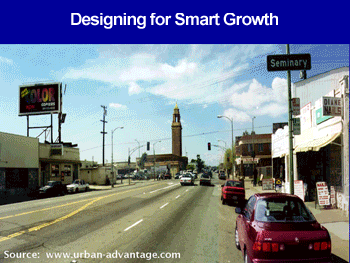Promoting Environmentally Friendly Building Practices
An important component of smart growth is design at the site level. In terms of street design, there are opportunities to create choices for transportation other than automobiles. Adding trees can help regulate the urban heat island effect, improve urban air quality and retain stormwater. In the example on the left, this redesigned street reflects a traditional neighborhood development design. This neighborhood has mixed land uses, making it more visually and commercially appealing by co-locating shops, restaurants, and offices and transportation.
Another smart growth technique for street design involves the incorporation of natural drainage systems. These systems replicate pre-development hydrology in contrast to the increased peak flows and reduced ground water recharge caused by traditional storm sewer systems. In Seattle, such systems have been highly successful in reducing urban street runoff and promoting infiltration, which reduces both downstream peak flows and runoff pollutants. A characteristic of natural drainage systems is that they also have associated vegetation and wildlife, thereby improving the aesthetic value of the streets on which they are installed. They help to meet multiple planning goals—community amenities, wildlife habitat, water resource management and aesthetic value.
Low-impact development (LID) is another aspect of smart growth that ties in well with water resource management. Natural approaches to stormwater management, soil amendments, vegetated swales, green roofs, bioretention areas, and raingardens are just some of the techniques that fall under the umbrella of this innovative approach. As the Puget Sound Action Team in Washington indicates in its March 2003 publication "Natural Approaches to Stormwater Management," LID is best distinguished by its central focus on stormwater management.
LID can support smart growth development and retrofitting of existing urban areas to improve watershed management. However, LID should be only part of the smart growth solution to a community's growth management issues. LID does not replace local land use planning; rather, it is a set of tools to better manage stormwater from areas appropriately designated for growth.
In summary, the smart growth principles of building, street and site-design promote:
- Innovative development decisions (i.e., green roofs and narrow roads) through predictable, fair and cost-effective paths to plan approval
- Mixed-use development
- The use of LID techniques.
References & Photo Credits
Growth Tools & Resources
![[logo] US EPA](https://www.epa.gov/epafiles/images/logo_epaseal.gif)

